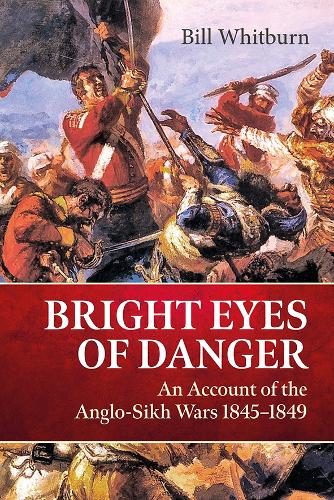
Bright Eyes of Danger: An Account of the Anglo-Sikh Wars 1845-1849
(Paperback, Reprint ed.)
Publishing Details
Bright Eyes of Danger: An Account of the Anglo-Sikh Wars 1845-1849
By (Author) Bill Whitburn
Helion & Company
Helion & Company
2nd July 2024
2nd July 2024
Reprint ed.
United Kingdom
Classifications
General
Non Fiction
Military history
European history
Asian history
954.031
Physical Properties
Paperback
344
Width 156mm, Height 234mm
Description
The Bright Eyes of Danger is rich in detail about the British advancement in India during the latter part of the eighteenth century, thus becoming the paramount power over all India except for the Sikh Kingdom in the Punjab. It gives a vivid account of the seven battles and one siege of the two wars with the Sikhs. The first was brought on by the demise of Maharaja Ranjit Singh, the machinations of palace officials and rapacity of the Sikh Army. Despite traitors in command, the Sikhs gave the invincible British Army a run for its money. The Battle of Ferozeshah was a closer run thing than Waterloo as the British Indian Empire stood at the brink of disaster. At the close of the first war many expected a British annexation of the Punjab, but the Governor-General, Sir Henry Hardinge, considered the Sikh real estate too large and expensive to take on, besides which annexation would not play well back home. He opted instead for a quasi-independent Sikh State, and in deference to the parsimonious East India Company Directors in London, he charged the Sikh State war reparations, annexed the most productive province of Jullundar and sold Kashmir to the 'biggest scoundrel in India' for 75,000. The second war erupted with a rebellion at Multan and the British Army advanced to battle with a new Governor-General and the same Commander-in-Chief, Lord Gough, whose catalogue of tactics did not extend beyond the awesome charge of British bayonets. This was not enough at the bloody onslaught of Chillianwala, where both sides fought to a stand still. At Gujerat Lord Gough, with a greater number of guns than Wellington had at Waterloo, crushed the Sikhs into submission and the Governor-General, Lord Dalhousie, annexed the Punjab. Having rocked the British Indian Empire at Ferozeshah, Ranjit Singh's soldiers helped save it during the Great Indian Mutiny, and later in both the World Wars. AUTHOR: The author was born in the Punjab and left India with his parents after Partition. He finished his education at the Jesuit College of Mount St Mary's in Yorkshire. After National Service he elected to go to the Royal Military Academy, Sandhurst and was commissioned into the Duke of Cornwall's Light Infantry. On completion of a Staff College course at Camberley, he was assigned to a staff appointment in Singapore. He was then seconded to the 10th Gurkha Rifles and served with them in Borneo. In 1969 he applied for early retirement and worked for a Chinese trading company in Taiwan for the next thirty years. In retirement he lives with his wife in Bayswater, London. The Bright Eyes of Danger is his first publication albeit he has had a number of articles published in military historical magazines. c 80 ills incl 8pp colour, 8pp colour maps
Reviews
" ... an enjoyable and educational read that represents a balanced and nuanced view of the adversaries and the climate within which they operated."-- "Sabretache"
" ... what a splendid book. The research ... included visits to the battlefields, while the result provides a vivid account of the seven battles in one siege of the two wars between 1845 and 1849..."-- "Military Historical Society"
" ... He has achieved a small miracle compressing such a colossal story into a single volume... An enjoyable read."-- "Chowkidar"
